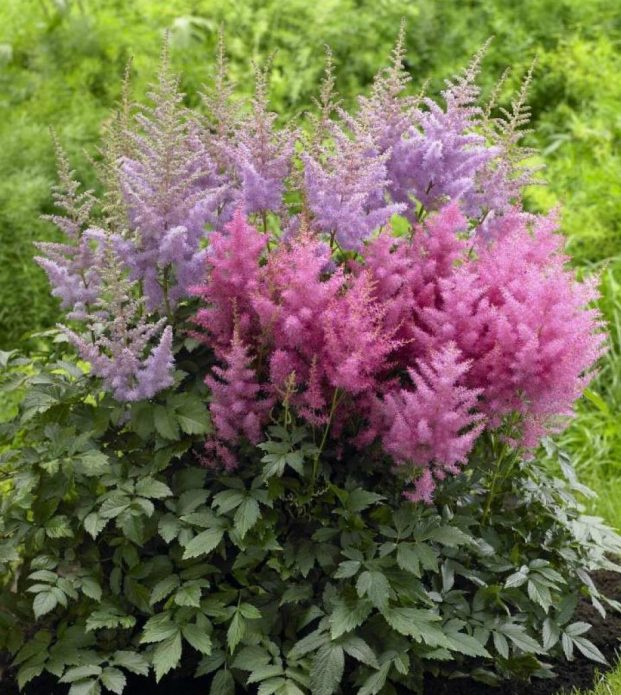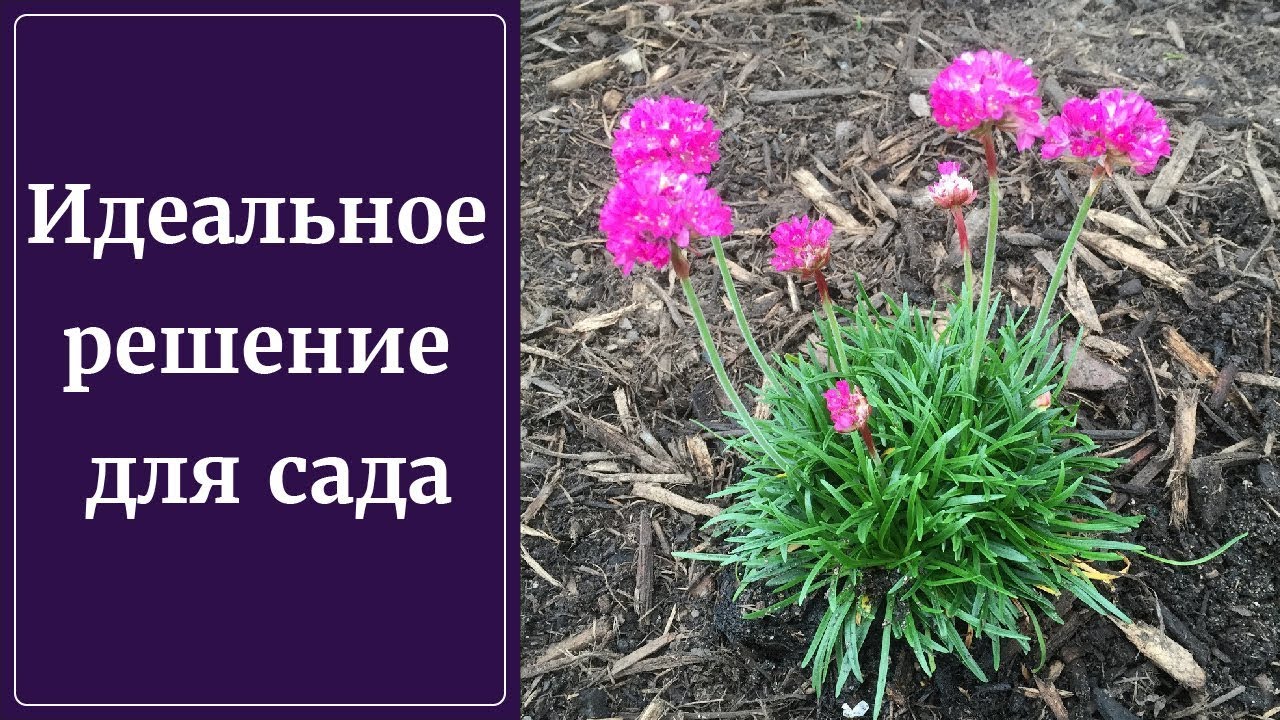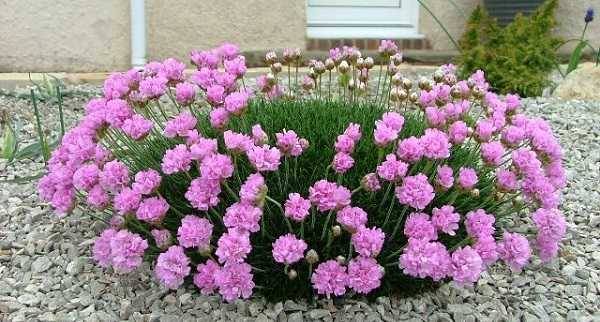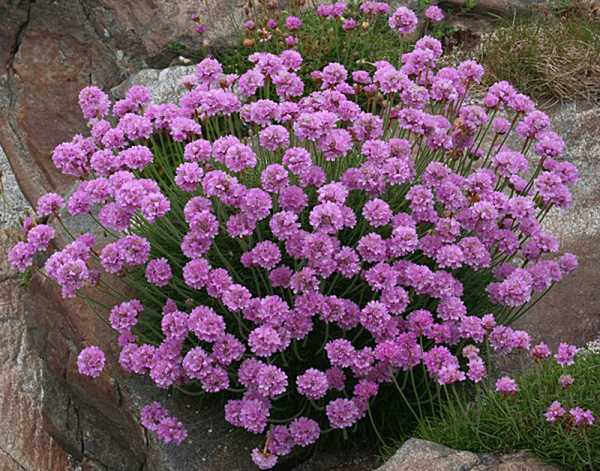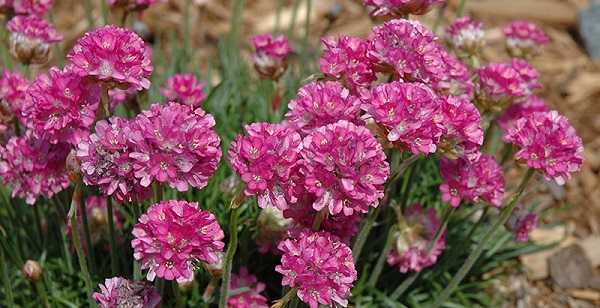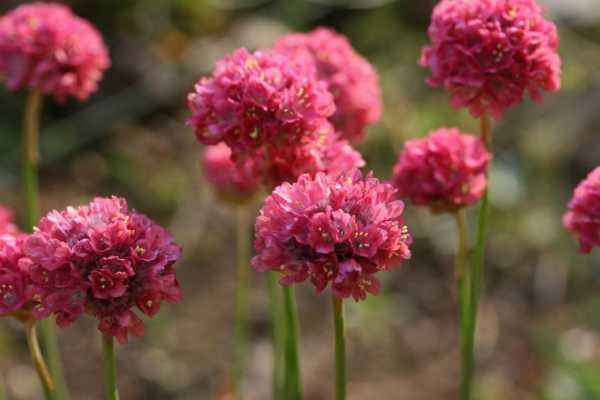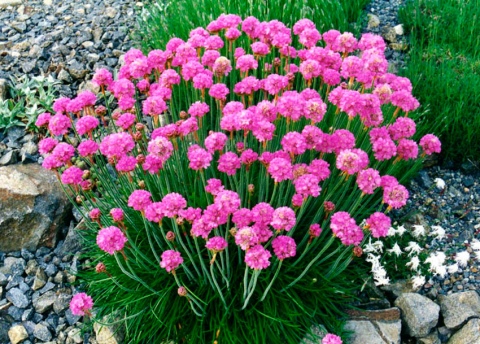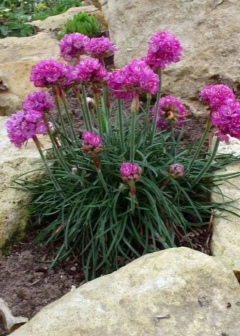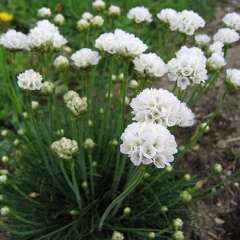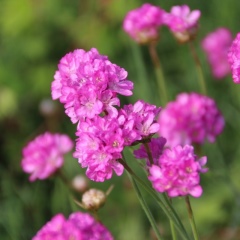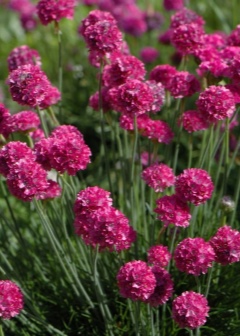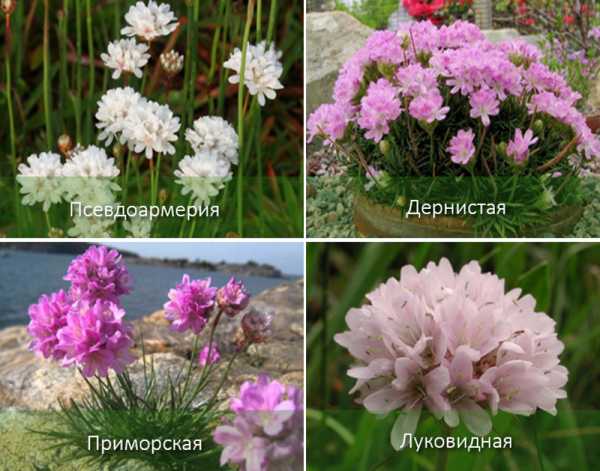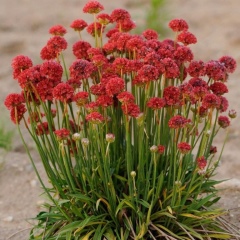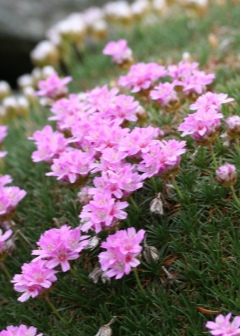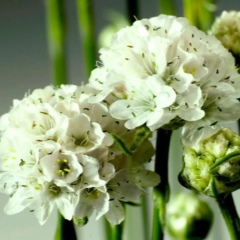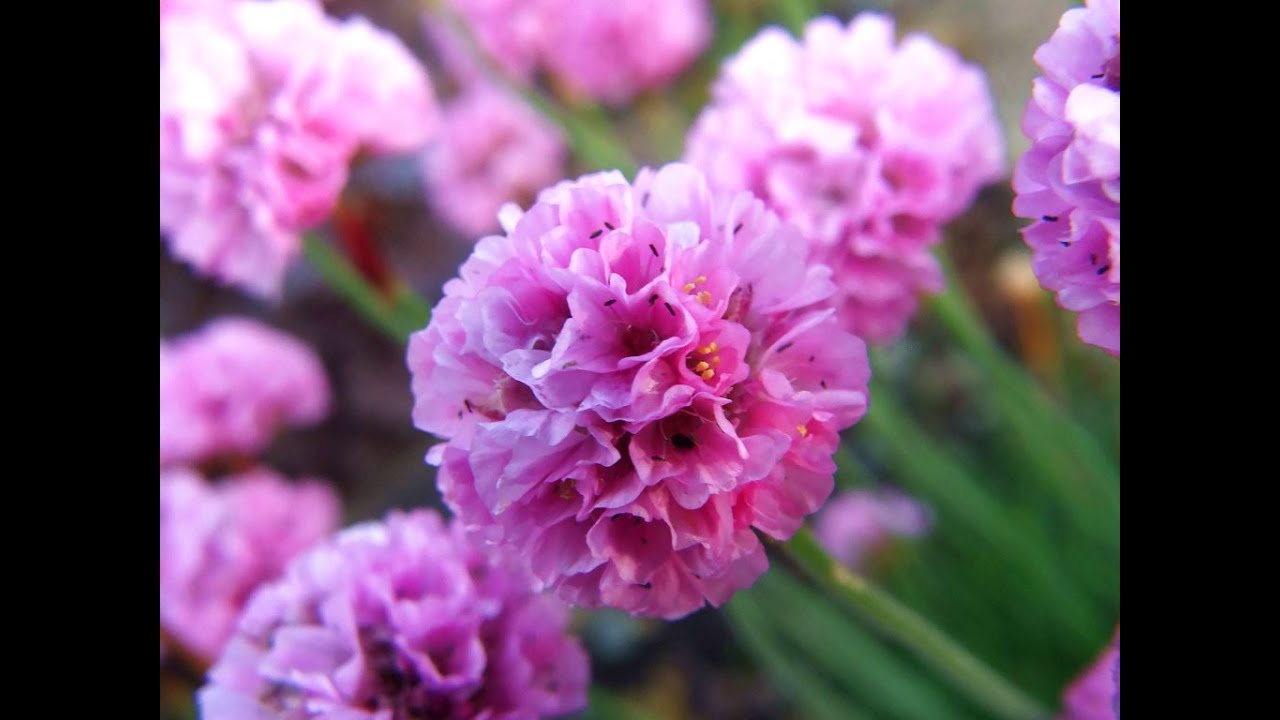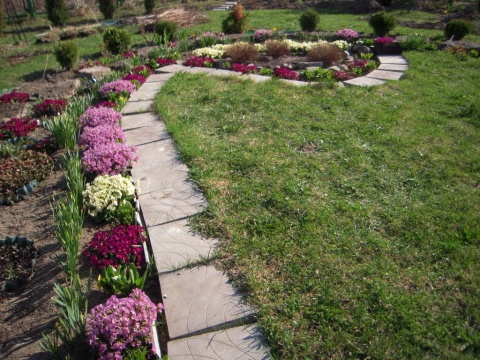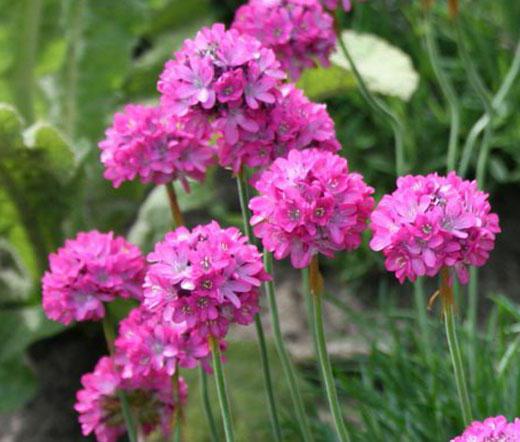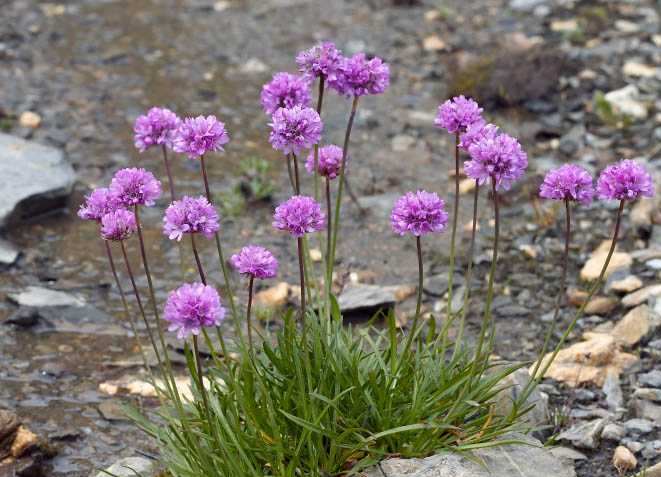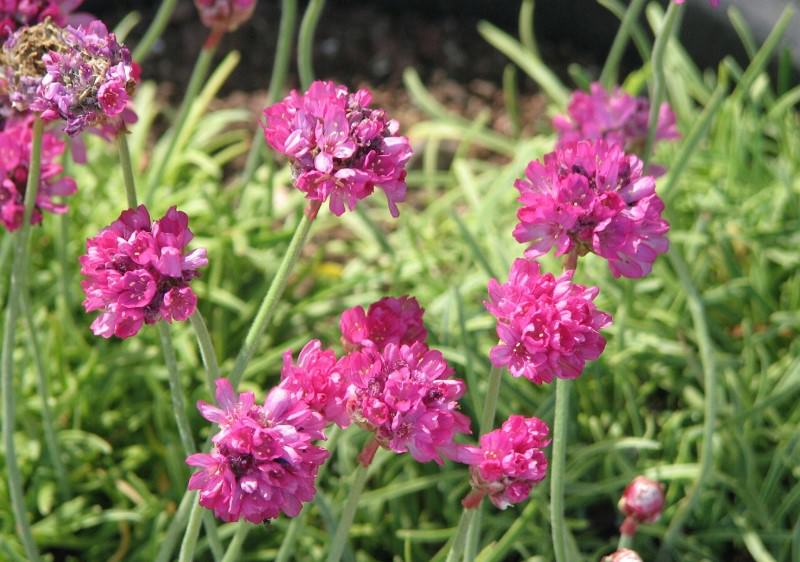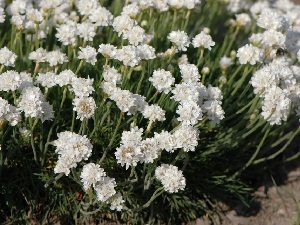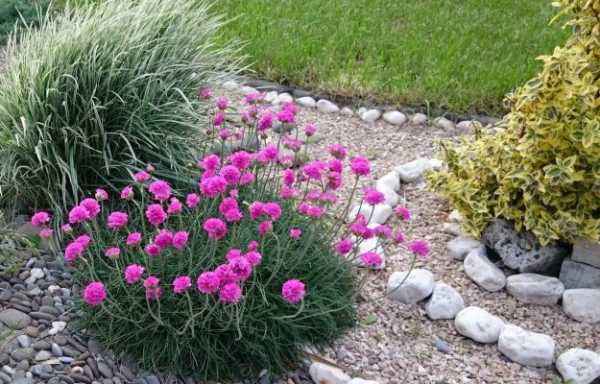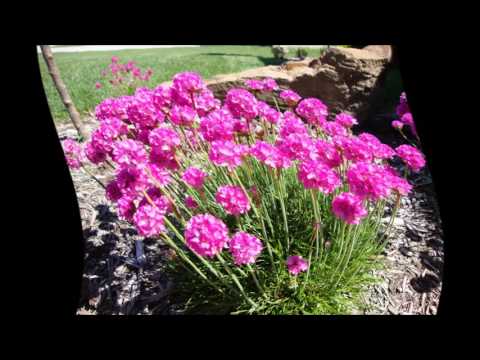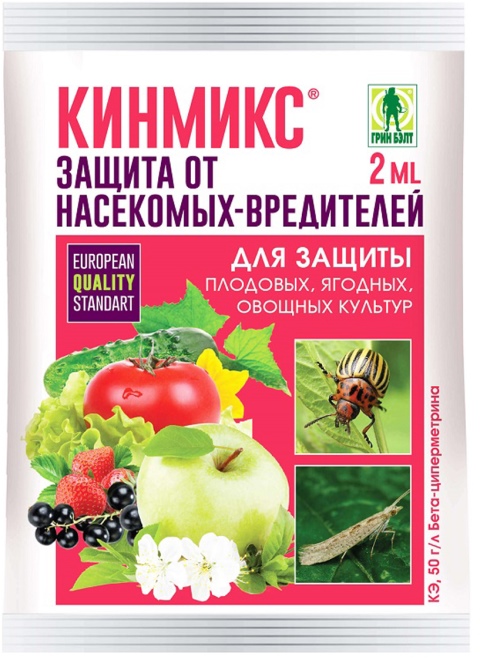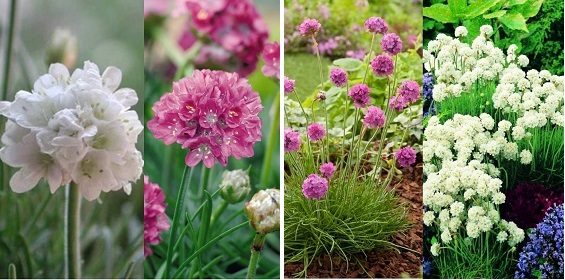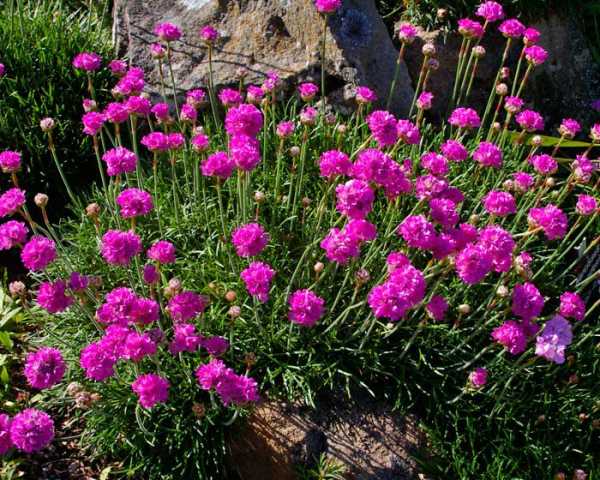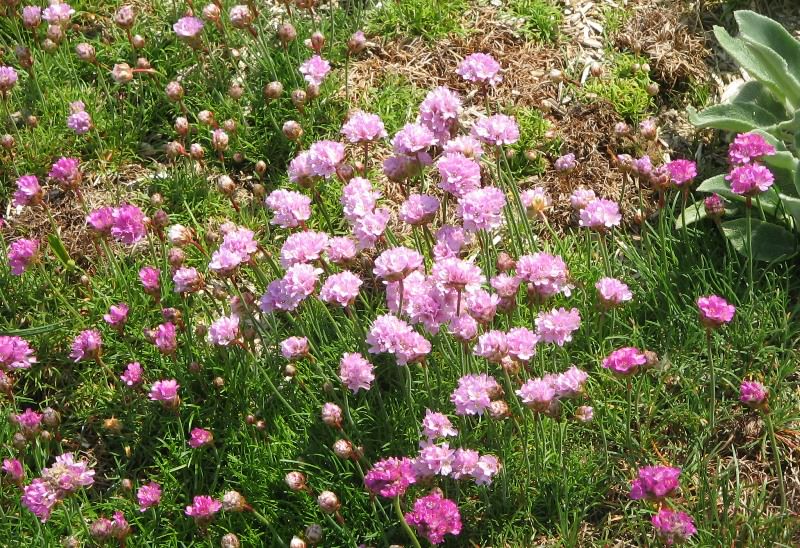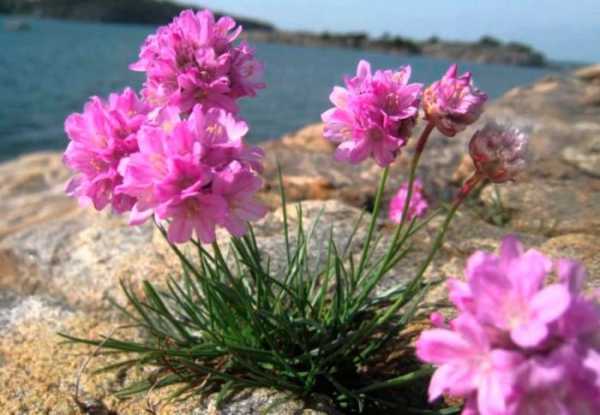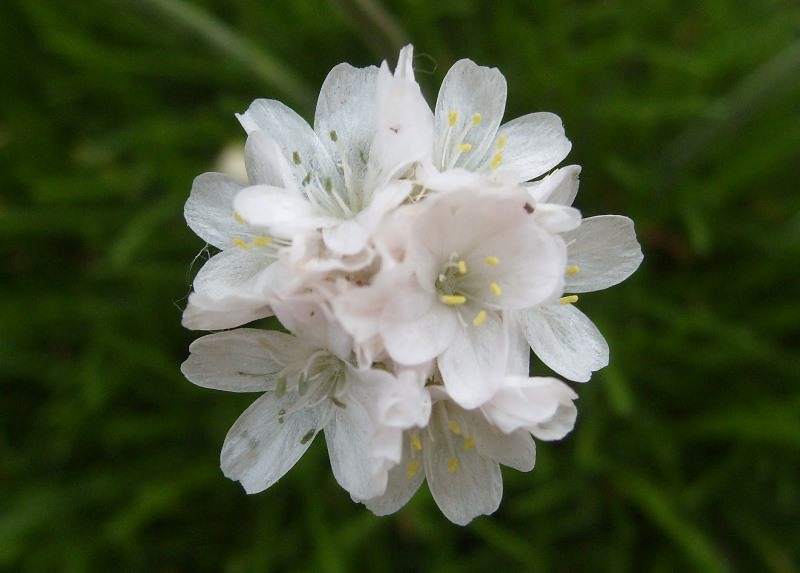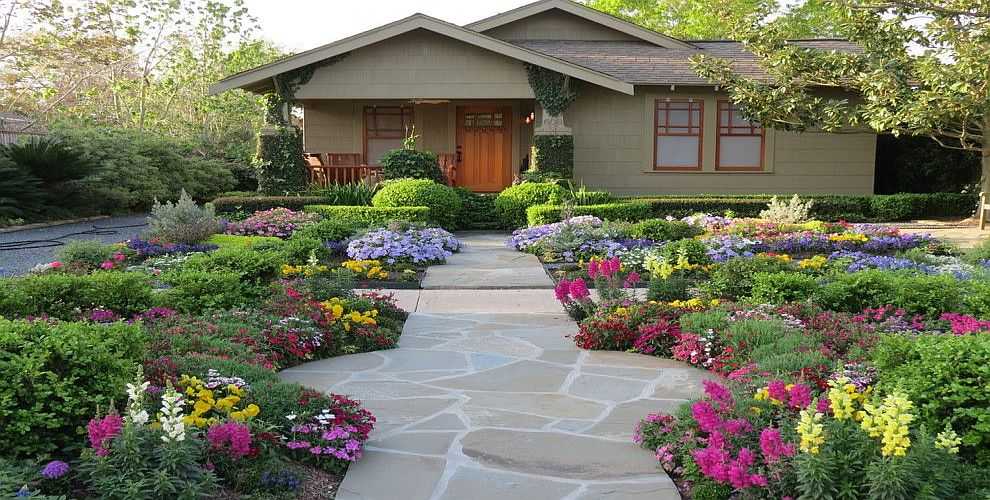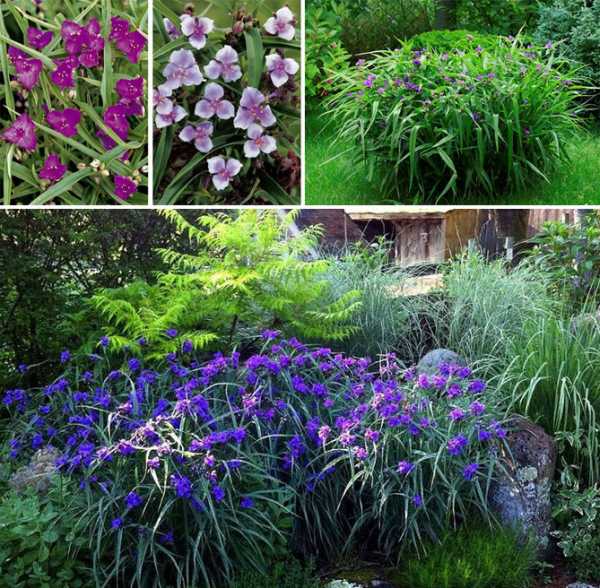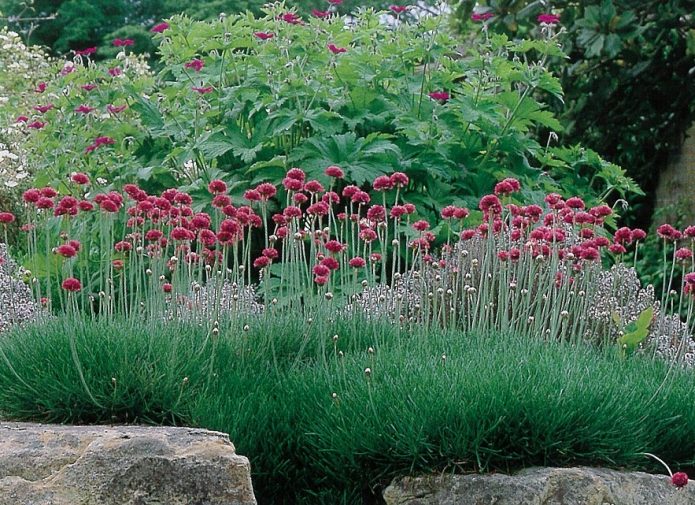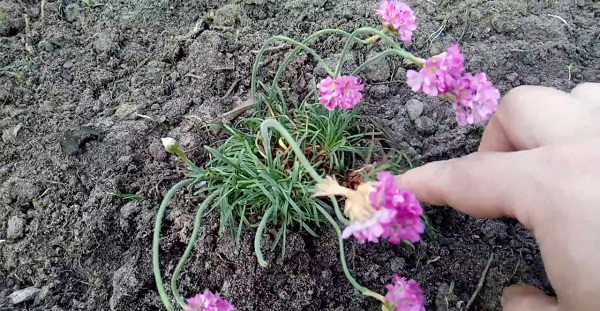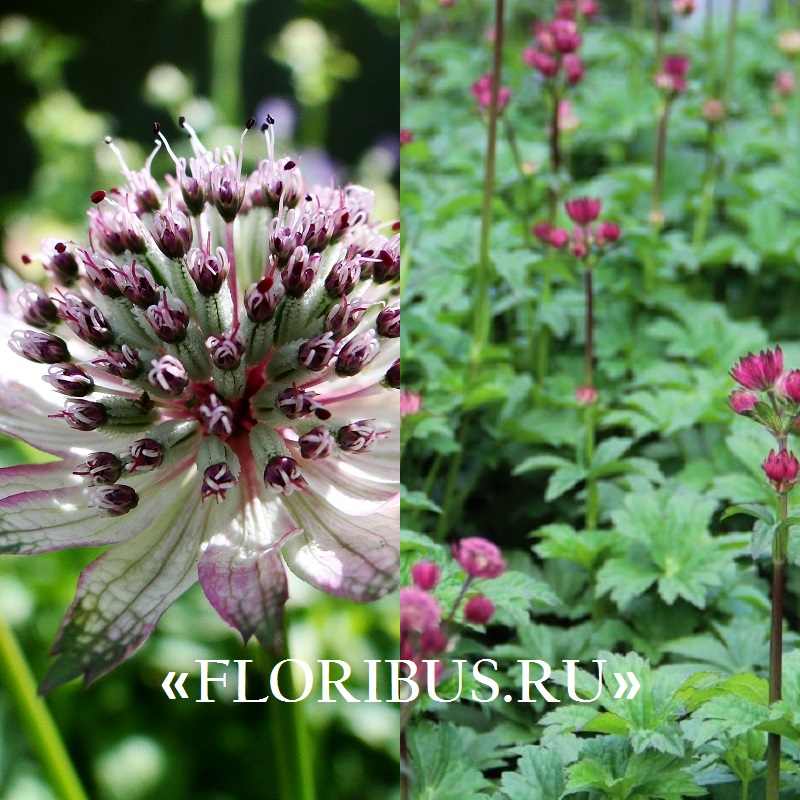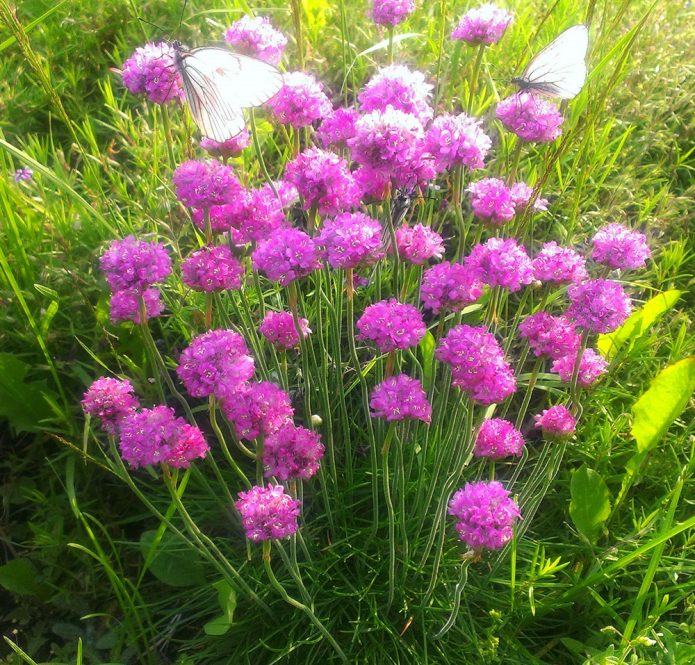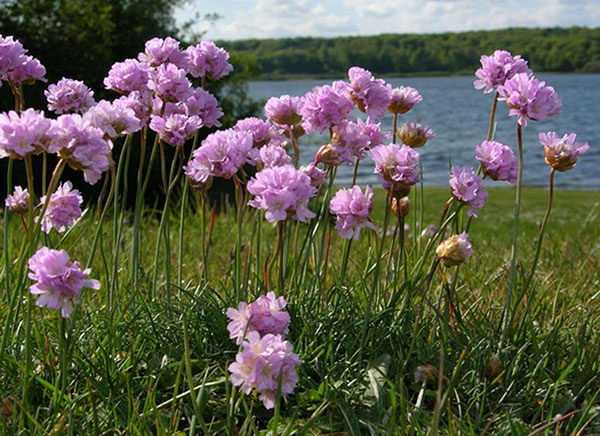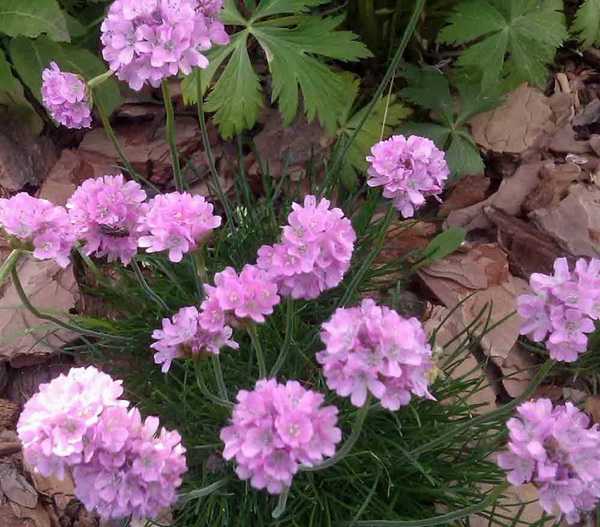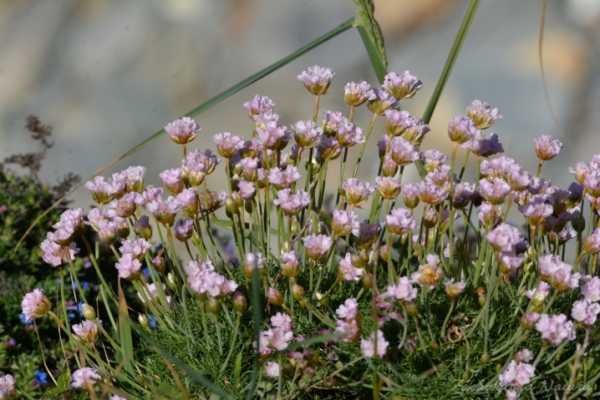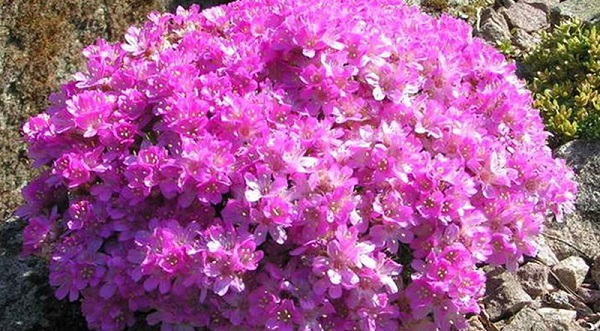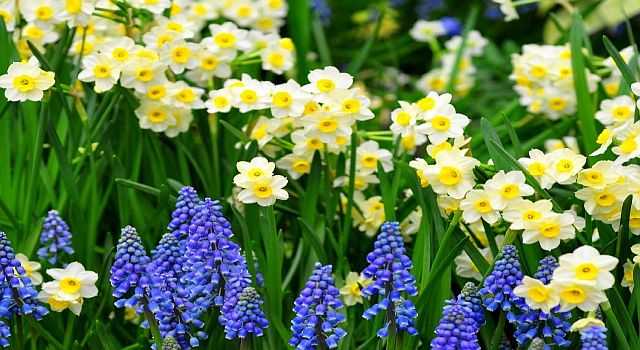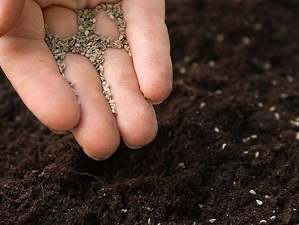Location and conditions
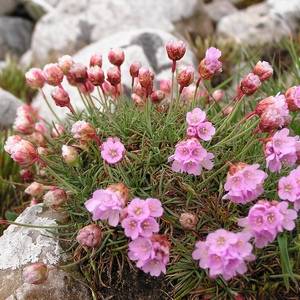 Armeria seaside is an unpretentious plant that can withstand prolonged droughts and frosts.
Armeria seaside is an unpretentious plant that can withstand prolonged droughts and frosts.
That is why it is grown in different regions of our country - both in the south, and even in areas with a rather harsh climate. In the wild, this flower can be found both in open areas of the steppe and in crevices of rocks.
The ideal place for planting armeria are sea terraces, rockeries, curbs. In the garden, any areas with sufficient illumination are suitable for her, including open ones (she is not afraid of the winds).
It is grown both outdoors and in containers. Container specimens tolerate heat better, but need more abundant watering.
Armeria seaside can overwinter even at very low temperatures (up to -15 degrees), but only under snow. In addition, it is very sensitive to an excess of moisture, therefore, watering should be done in doses, as the soil dries.
But this rule applies only to the dormant period, in spring or summer, with a lack of watering, the plant immediately begins to dry out. With constant precipitation and oversaturation of the air with moisture, it is better to sprinkle garden gravel around the stem, which will take excess moisture onto itself.
Reproduction of Armeria
-
Reproduction by seeds. You can sow seeds directly into open ground in a previously prepared place. For the best germination of seeds, they must be placed in warm water for 7-8 hours before planting. The best time for sowing is early spring or late autumn. You can also take advantage of growing seedlings - sow seeds in boxes placed in a warm place. Then dive the grown seedlings into the greenhouse or into the open ground and cover them with a film. Sowing time with this method: last days of winter or early March.
Armeria seeds
- When propagating armeria by cuttings, small rosettes should be selected and cut from plants. They need to be planted in the ground. To do this, dig a shallow hole, place a stalk, sprinkle with earth, slightly compact the soil and water. Cuttings should not be planted too deep or they will not germinate. The distance between the bushes should be about 25 - 30 cm. Cuttings can be planted throughout the summer season.
- For reproduction by division, bushes are used at least two to three years. This is done in early spring or autumn, when the plant has already bloomed. The bushes should be dug up and cut into pieces. Places affected by rot must be cut, cleaned and sprinkled with crushed activated carbon. The resulting small parts must be planted in open ground at a distance of 20 cm from the bush from the bush.
This section covers all the main points on the topic: armeria growing and care. They will be very useful for flower growers who decide to plant this beautiful plant on their site.
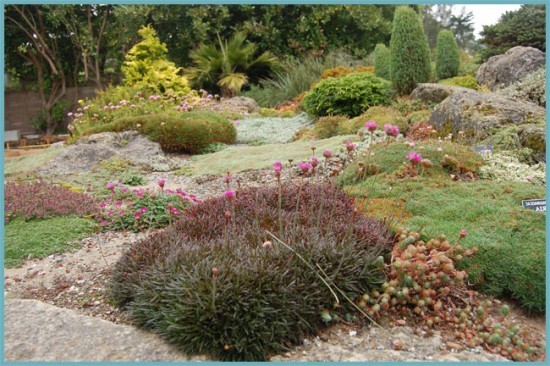 Armeria in landscape design
Armeria in landscape design
Pests and diseases
Caring for the armeria is simple. Practically unaffected by pests and diseases. The only insect that a flower can choose is aphid.
If aphids are found on the bushes, sprinkle the ground around the plant with tobacco dust. An infusion of tomato tops will help get rid of the insect.
Long-term Armeria cannot stand the presence of alkali in the earth. A sign of insufficient soil acidity is the appearance of spots throughout the plant. You can only fight this problem by pruning the bush and acidifying the land.
Root rot occurs due to stagnant water, abundant flooding of roots, and insufficient drainage.To reanimate the plant, the bush must be dug up, the damaged parts of the root system must be cut off and transplanted to another place, following all the recommendations.
Description
The perennial armeria plant (planting, care and photos of it are discussed in this article) reaches a height of 60 centimeters. It has a pivotal short rhizome, while numerous linear-lanceolate sessile sessile leaves, collected in a common rosette, form pillows - rather dense clumps. The stem of the plant is pubescent, smooth or straight. Small flowers of pink, white, purple flowers, as well as their shades, are enclosed in capitate inflorescences. Single-seeded fruit. Flowering begins in May and ends in late summer. The most popular in culture is the seaside armeria. Growing it is carried out in the same way as growing a plant of another type. The main difference is considered only that the first is preferable to grow near a reservoir.

Planting and breeding methods
The seaside armeria reproduces in several ways:
- Seeds.
- Seedlings.
- Vegetatively.
- By cuttings.
Let's consider each in more detail. You can choose any that is convenient, but you should take into account the age of the plant. Not all methods are good in the early years of the Armeria's life.

Planting seeds in the ground
Sowing in this way is recommended more for the southern regions, because the seeds germinate very early, and if they fall under night frosts, they may suffer.
- This method should be used at the end of autumn.
- Seeds planted before the cold weather will undergo a natural process of stratification. Can also be planted in early spring, in March. Seeds are planted shallowly into the ground, no more than 0.5 cm. The germination rate of the seaside armeria is quite high.
- Before planting, it is necessary to prepare the required soil composition. It is desirable that it resemble natural conditions: the soil should be drainage, mixed with sand. Stony soil is also good. Sometimes loamy is used, but then it should be loose in composition and contain the required amount of moisture.
- A place without shade is required (shading from other plants is not encouraged) and excessive dampness, well illuminated by the sun.
It is necessary to sow in the ground at the end of November, and already at the beginning of spring the first shoots appear. Closely monitor the condition of the soil for moisture. Excess moisture, flooding after snow melting should not be.
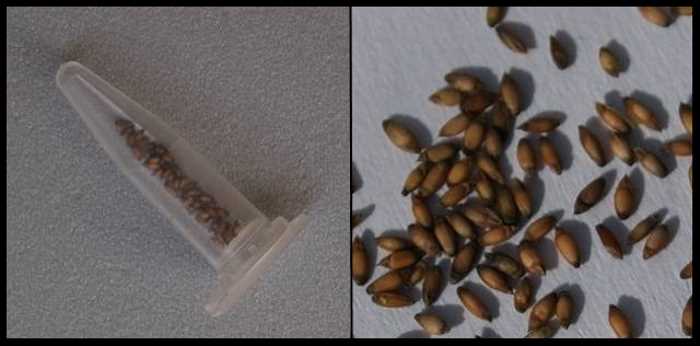
Seedling method
Seedlings may require a small greenhouse, container and glass. Growing should begin in mid-February.
- Before sowing, seeds must be stratified in the cold (cool room or refrigerator) for 14 days.
- Before planting, you need to soak the seeds in warm water for 7 to 8 hours.
- Make the holes very shallow and cover the seeds only a little with earth, no more than 1 cm. The soil should include sand and peat.
- The temperature for good growth of seedlings can range from 15 to 22 degrees.
- The first shoots should appear within 14 - 21 days.
- Seedlings are planted in open soil in mid-May. Before that, young shoots develop in a container and thus are protected from the last spring frosts.
It must be remembered that plants planted in this way begin to bloom only in the second year and do not tolerate calcareous soil. Therefore, it is worth getting rid of lime by pouring ammonium nitrate into the soil before digging or pouring vinegar solution over the proposed planting site.

Vegetative propagation
Every year the armeria bush forms many basal processes. In August, after flowering, the plant should be completely dug out of the ground. Then divide into the required number of parts. Try to select parts so that there is a strong root system. Then the bush will take root faster.
This method is only suitable for a three-year-old armeria, because the root system will already be sufficiently developed, and the plant will painlessly survive the separation of the turf.
In addition, five-year-old plants begin to bloom less, but they increase the volume of green mass, so renewal is necessary. Young bushes should be planted at a distance of at least 20 cm from each other.
Cuttings
This method can be used throughout the summer period. The shoot can be separated with a weak rhizome or without it at all.
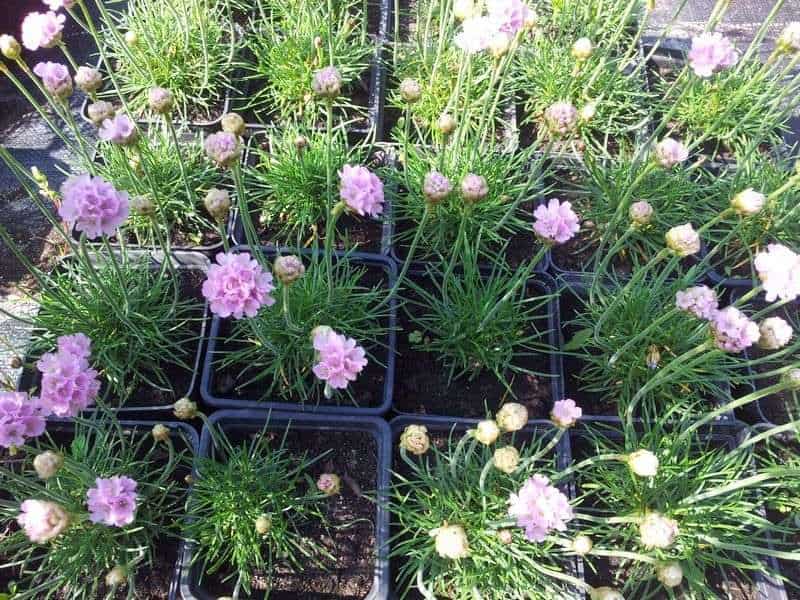
The stalk should be planted in well-loosened drainage soil. First cover it on top, but do not forget to air and water. Armeria planted in this way takes root very well and grows quickly.
Planting site, soil
Despite the fact that armeria is a completely unpretentious plant, there is a certain number of rules that should be followed in order for this flower to feel most comfortable in the summer cottage. The landing site should be chosen open, with good sunlight.
The soil is preferable light, loose, moderately moist. Before planting a flower, you need to add mineral and organic fertilizers to the soil several times.
Important! An acidified substrate is required for a flower, a neutral level of acidity is acceptable, but lime soil is not acceptable. In addition, the soil is required should be light and loose, in heavy soil, moisture accumulation and stagnation is possible, which the flower categorically does not tolerate
Therefore, if the soil is heavy, it is worth organizing additional drainage. For self-preparation of the soil mixture, you will need a greenhouse mixture, river sand and sod, taken in approximately equal proportions. Armeria, planting and caring for it in the open field are simple, even a beginner can master the process of reproduction and growing a flower
In addition, the soil must be light and loose, in heavy soil moisture can accumulate and stagnate, which the flower absolutely does not tolerate. Therefore, if the soil is heavy, it is worth organizing additional drainage. For self-preparation of the soil mixture, you will need a greenhouse mixture, river sand and sod, taken in approximately equal proportions. Armeria, planting and caring for it in the open field are simple, even a beginner can master the process of reproduction and growing a flower.
Sowing seeds in open ground
Sowing in open ground is carried out in the case when it is necessary to get a lot of plants at once or when there is a desire to have different new varieties on its site. Seeds are planted in open ground in early spring or late autumn.
Step-by-step instruction:
- Choose and prepare a landing site.
- Choose the right soil or prepare the substrate yourself.
- Spread the seeds over the surface of the loosened soil, lightly tamp the soil and sprinkle with a small layer of earth.
In the future, the plant will perfectly reproduce by self-seeding. When sowing seeds, flowering will occur only in the next season.
Important! Seed germination is very high, almost 100%, so if everything is done correctly, you can not worry about the result
Planting Armeria seedlings in open ground
Planting seedlings in open ground is carried out as soon as the threat of night frosts has passed. In Central Russia, this is usually the end of May. Young plants are planted at a distance of 30-40 cm from each other. If the flowers are planted so that they form a carpet as they grow, the distance is halved.

Armeria seedlings
Armeria flower care in the open field
Armeria is considered to be a rather unpretentious flower, which, however, can be seriously damaged by excessive watering and excessive fertilization - this leads to the dying of the plant.
Watering the plant

Armeria tolerates drought quite well
Despite the fact that Armeria calmly tolerates drought, on hot days it must be actively watered, because it loves moisture very much.
Flower feeding
During the season, it is recommended to feed the armeria several times: at the beginning of growth, during flowering and after it.Thanks to mineral and organic fertilizers, flowering will be more abundant. If the plant is planted in peat or clay soil, then it needs to be fed more often.
Pruning
Cutting off empty peduncles after flowering profusely is necessary so that the plant can bloom again. Also, wilted inflorescences are removed from the armeria so that it has the opportunity to form new flowers.
Winter care
Armeria successfully adapt to the winter cold, during which they do not lose their bright green color. Additional manipulations with the plant before wintering are not necessary, with the exception of turfy armeria: it should be covered with covering material, spruce branches or dry peat.
However, if winter is expected without snow, it will not be superfluous to shelter other species of armeria.
How to harvest armeria seeds after flowering
It is necessary to collect the seeds of armeria as follows: tie the flower with gauze, and after it is completely dry, cut it off, shake out the seeds on a leaf, clean it of debris and pour it into a paper bag.
Care features
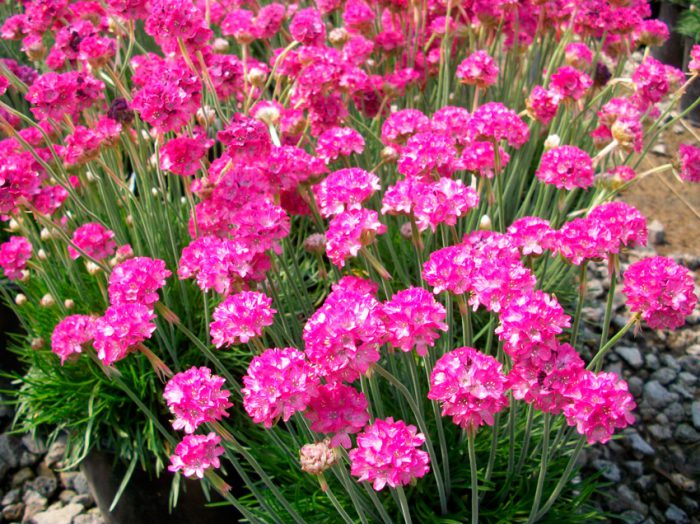
It is very easy to care for such a flower. Before flowering, it is recommended to apply a complete mineral fertilizer to the soil. After that, the plant is fed in the same way 1 or 2 more times. Fading flowers should be cut off in time, and those peduncles on which flowers will no longer appear should be removed. As a result, the stored strength of the flower will be spent on the emergence of new buds. During the dry summer period, watering should be regular, but the soil should not be overmoistened. After the Armeria turns 5 years old, it is necessary to dig out a bush and divide it into parts, and then plant it. And then this procedure should be done 1 time in 2 or 3 years, otherwise the flower will grow.
Diseases and pests
The plant is highly resistant to various diseases and harmful insects. However, if the acidity of the soil is less than necessary, then the armeria may have problems with spotting or aphids. To combat such misfortunes, radical pruning of the stems is used.
Features and varieties
Armeria belongs to the genus of herbaceous flowering perennials of the Lead family. This genus unites about 90 species of different plants. According to one version, the name of this flower comes from two Celtic words such as: “ar” - “close, nearby” and “mor” - “sea”. So, to prove this version, a species was discovered that grows in the Armeria, while it loves to grow in the seaside dunes.
There is also a version that the name of the armeria stemmed from the word "armoires", this is how the bearded carnation was called in the old French language, and several varieties of armeria look like it. Under natural conditions, such a plant can be found in the Mediterranean, America, Eastern Europe, Mongolia, and of course in Siberia.
Varieties and types
No wonder the Armeria is called a wild bearded carnation, there is a certain similarity. It is also called the sea flower, since it is the sea coast, even the rocky one, that serves this culture as a favorable environment for growth.
There are a huge variety of its varieties, about 90. But in Russia, certain well-known varieties are especially popular:
- Alpine. This perennial culture is very common in our country. Delicate pink flowers are combined in landscape design with almost any neighbors in the field of gardening. A low stem up to 15 centimeters high with long peduncles up to 30 centimeters allows this species to be used as decorative borders. There are varieties with white (Alba), carmine pink (Rosea) and carmine red (Laucheana) flowers.
- Armeria is beautiful. The variety is considered evergreen, the leaves overwinter easily under the snow. The plant grows to a height of 40 centimeters with rosettes of leaves and inflorescences of snow-white (Joystick White), bright pink (Bees Ruby) and even burgundy flowers (red planet). Blooms from early to late summer.Other names for this variety are Louisiana, pseudo-army.
- Armeria seaside. This type is one of the most popular, perfect for rocky gardens and artificial surroundings of reservoirs and waterfalls. It grows along the sea coasts. Differs in high drought resistance. Varieties with white (Alba, Cotton Tail), pink (Rosea Compacta), scarlet (Vindictive), dark red (Düsseldorfer Stolz, Bloodstone) flowers have been bred.
- Armeria is soddy. Probably the only variety of armeria that cannot withstand the winter, even the warm one, without help, the bushes should be covered for the cold period. But in summer, the plant can bloom so generously that even the foliage is not visible. Popular varieties with double lilac (Brno) and pale pink (Bevan's Variety) flowers.
Seed collection
In the event that armeria is grown in your garden, then there is no particular need to collect its seeds, since it reproduces excellently through self-seeding. And you should not forget that the bushes will need to be planted regularly, while dividing them into dells, and the sowing plants will multiply with their seeds, so you will probably have enough planting material. In the same case, if you want to share the armeria with someone, then it is better to give part of the cut or cut a few cuttings.
However, if you really need seeds, then the inflorescence, which will begin to wilt, will need to be tied with a piece of gauze, which will prevent the seeds from falling to the surface of the soil. A completely dried inflorescence should be carefully trimmed. The seeds need to be shaken out on a leaf. After that, they are cleaned of plant residues. When the seeds are dry, they should be poured into a paper bag.
In landscape design
The culture is almost ideal for alpine slides and rock gardens. Wherever there are gaps in the stone on the territory, the armeria can be planted, and the combination of the grayness and coldness of the stone with bright velvet flowers will always be successful.
Armeria can often surround artificial reservoirs, areas for serene relaxation, border the beds of other crops. In flower gardens, the plant successfully coexists with creeping phlox and Carpathian bell. Armeria inflorescences on high peduncles, cut before blooming and dried, are used to create winter bouquets of dried flowers.
Armeria planting, care and fertilization
Even for such a picky plant as armeria, planting and care should be carried out according to all the rules.
Armeria Primorskaya feels great on well-lit areas sun with light, loose and slightly moist soil. Damp stony or sandy loam soil with an acidic reaction, but in no case calcareous, is best suited. Before planting the plant, the soil must be loosened a couple of times and fed with organic fertilizer.
If the soil is not suitable for armeria, it can be prepared: take a special mixture for greenhouses, add river sand and sod soil (1: 2: 2). In the areas where the shoots will be planted, dig shallow holes or trenches and fill them with the prepared mixture. You can also add sawdust, hay, crushed dry grass, humus from the needles when digging the beds. This "vinaigrette" will improve soil drainage and also serve as a natural fertilizer for the flower.
 Prepare the soil for planting armeria by adding all the necessary components
Prepare the soil for planting armeria by adding all the necessary components
Armeria seaside tolerates the heat well, but it needs to be watered regularly (but in moderation), and on especially hot days, the leaves should be sprayed.
Important! Another important point of care is that you need to loosen the soil from time to time.
When Armeria begins to bloom, for abundant and long flowering, it is imperative to cut off wilted inflorescences and flower stalks, on which there will no longer be buds. So the plant will not waste its energy.
In a snowy and not too cold winter, the Armeria does not need to be covered. It tolerates frosts well down to -15 degrees, and winters well under the snow.But when there is no snow, then for the winter it needs to be well covered, for example, with spruce branches.
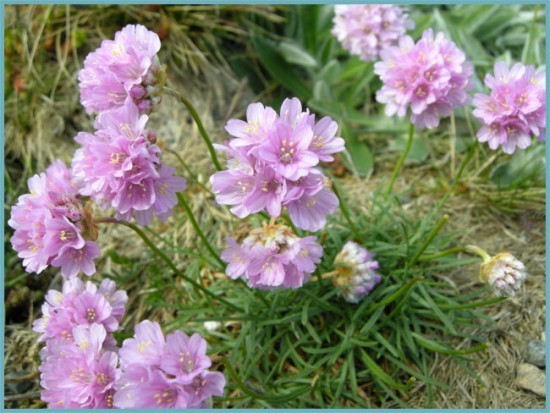 Armeria takes leaf spraying very well
Armeria takes leaf spraying very well
Armeria must be fed before flowering. Actually, for normal development plants, it is advisable to carry out three dressings per season, watering with an aqueous solution of fertilizers (organic and mineral). Especially if the flowers grow on peat, clay and loamy soils.


